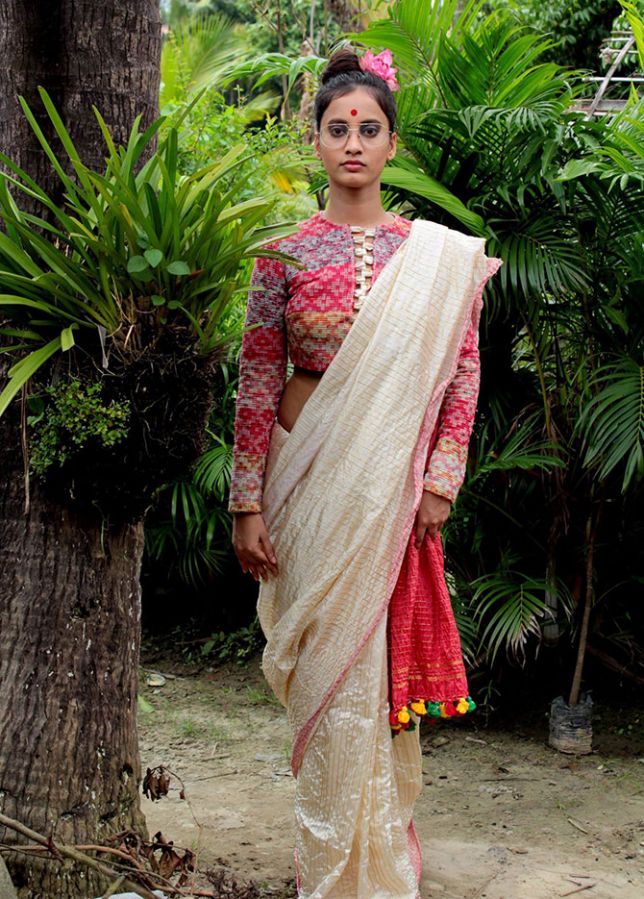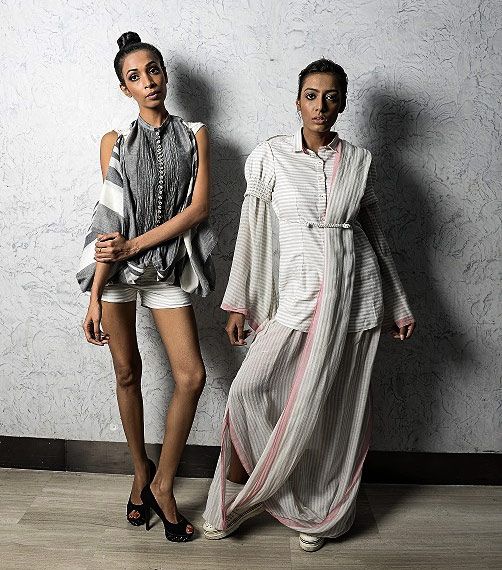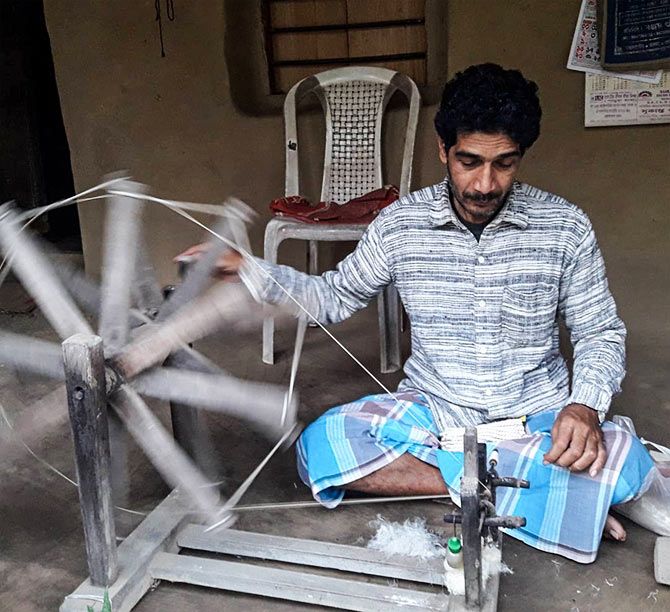'My collection for LFW is all about Indianness.'
Fashion designer Soumodeep Datta quit computer science to pursue his dream.

Photograph: Kind courtesy Soumodeep Dutta/Facebook
In less than two weeks, Soumodeep Datta will make his debut as a GenNext designer at the Lakme Fashion Week Summer/Resort 2017.
Quiz him on his excitement levels and he says, "When I heard that our show is on February 1, I thought 'runway' or 'run away'?"
A star student from his batch at the National Institute of Fashion Technology, Ahmedabad, Soumodeep is the first fashion designer in his family.
He was in his first year of computer science engineering, when he got to know about fashion designing. He took the leap of faith and gave it his all.
In an e-mail interview with Rediff.com's Anita Aikara, he speaks of his journey and Connecting Link, his collection which celebrates traditional Bengali drapes.
Soumodeep has been a semifinalist at Wills Lifestyle Debut 2013 and a winner of the National Design Competition 2013.
Presenting Soumodeep Datta, the first designer in the GenNext Class of 2017, where we introduce you to five emerging designers, who will showcase their collection at LFW 2017.

Photograph: Kind courtesy Lakme Fashion Week
Age: 28 years.
Hometown: Kolkata.
Design school: NIFT, New Delhi.
You are going to debut at LFW. How are you dealing with it? Excited?
It's crazy out here...running to remote villages to sit with my weavers, planning the show looks and final garments and all the other preparations required!
Participating in such a huge platform for the first time involves equal amounts of excitement and panic.
What was your childhood like? Did you always want to become a fashion designer?
I come from a middle-class Bengali family. I was born in Dhanbad and later we shifted to Kolkata.
My father is an Eastern Railway employee and my mother is a typical homemaker, who has always instilled culture and tradition in our upbringing.
My sister is older to me.
In my family, I'm the first fashion designer. This gives enough curiosity among relatives as well.

Photograph: Kind courtesy Lakme Fashion Week
My childhood drawing classes formed the base of me being a designer today.
My love for drawing inspired me to sit for the NIFT entrance, which is an all-India entrance exam.
I was in my first year of computer science engineering, when I got to know about NIFT.
When my mind was bound by physics, chemistry and mathematics, the curiosity about the curriculum of fashion design made me overcome stereotypes.
In my first attempt, I got AIR (All India Rank) 25 in NIFT. That was the support of fate.
My dad could not see a future in this field, so he saw no reason of leaving engineering for fashion design. But my mother and sister supported me to listen to my heart.
Today, I can say that you must follow your heart even if things are uncertain.
What was your first assignment? How much did you earn?
My first earning was from a fashion week.
I had to assist designer Rahul Mishra at his stall in 2010. Working with his team was a happy feeling. I earned Rs 2,500.

Soumodeep has used age-old Bengal muslin, which has been woven in remote and unexplored villages in Bengal.
Photograph: Kind courtesy Soumodeep Dutta/Facebook
Is it true that you were the star student of your NIFT batch?
Yes! My graduation collection in NIFT was selected as the 'Best use of Viscose' and I won a cash prize of Rs 50,000 from AMFII (an association of manufacturers producing viscose filament yarn and viscose staple fibre in India).
The same month, I was the winner of the National Design Competition 2013 held by Gokaldas Exports, Bengaluru.
I received a cash prize of Rs 100,000 along with a winner's trophy from Gokaldas Exports.
Was it easy cracking the LFW GenNext designer auditions?
It was not easy to get through the selection.
It required a lot of pre-planning and hardwork along with an unflinching dedication and love for fashion.
This was the second time I applied for the auditions.
The first time taught me lessons which helped me this time.
As they say, failure is the pillar of success!
Tell us about your collection at Lakme Fashion Week.
My collection for LFW is all about Indianness.
It's about an Indian women with a modern lifestyle, without imitating the West.
She has an inclination towards art and culture. So we can say it's about Modern India.
The garments are inspired by the sari -- the Bengali style of draping a sari is a constant inspiration (for me).
Like a sari, which is a single piece of fabric, most of my designs are also made of a single piece of fabric.
It is all about draping the piece of fabric; the stitched garments have the essence of a sari.
The garments have a sense of continuity -- the front becomes the back or the back comes in front like an infinite loop.
I have used age-old Bengal muslin, which has been woven in remote and unexplored villages in Bengal.
The collection is called The Connecting Link.
It is inspired from the opposites of nature like good and bad, day and night, man and woman, black and white.
I feel when these opposites meet, God is evoked.
Like dawn and dusk is believed to be the time of God.
Similarly I feel God is neither black nor white. He is grey!
There's a lot of Bengali culture, tradition and influences to look out for in the collection.
What are the summer trends to look forward to?
Fashion has turned towards minimalism, comfort, utility and adaptability.
People prefer simple, comfortable clothes than gaudy, uncomfortable ones.
Neutrals like black, white and grey are in for summers.
Asymmetrical is a huge trend coming up, where you'll get to see the stereotypes in garments being broken -- subtle asymmetry in pattern and drapes are going to come along.
Multi-functional garments and interesting sleeves are in.










